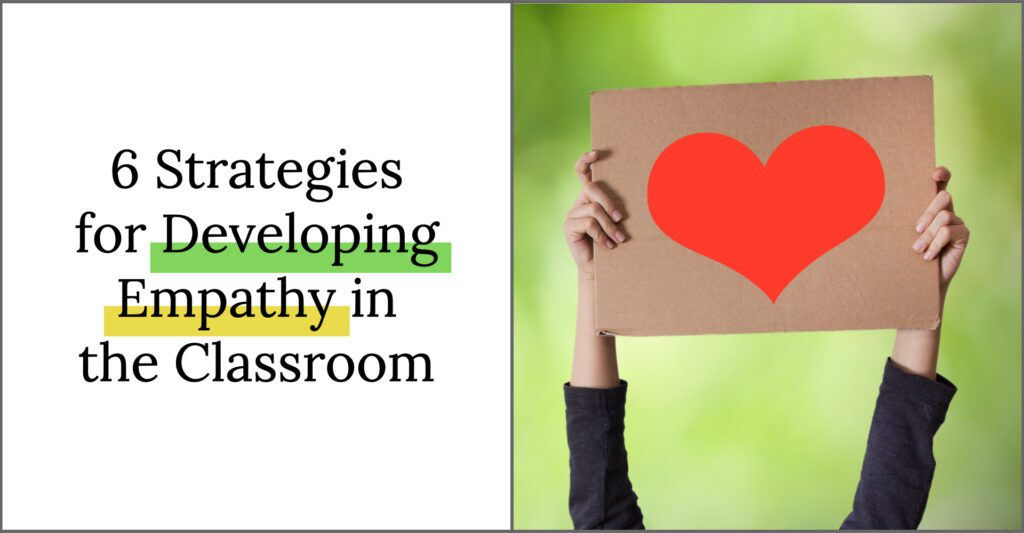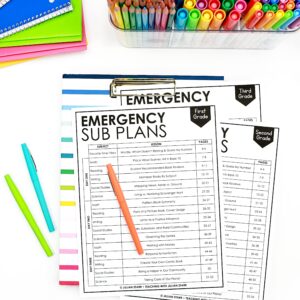
As teachers, a huge part of our job is to create a classroom community that is supportive and inclusive. We know that if students don’t feel safe and valued, then they simply won’t be available for learning. This is why it is so important to cultivate a classroom community that supports students in developing empathy.
Why Developing Empathy in the Classroom Matters
Creating an inclusive and supportive is no small feat, and developing empathy is one of the most challenging pieces of the puzzle. We’ve all been there with our students, wondering when empathy will click for them or thinking how much easier x,y, or z would be if our students approached the situation with empathy. Not only does it help our classroom run more smoothly, but I’d argue, even more importantly, practicing empathy is a vital life skill that will help our students:
- Understand their peers, family members, and neighbors
- Navigate social situations at home, school, and in their communities
- Choose appropriate actions and responses based on an understanding of someone else’s feelings or situation
So important, right? Let’s do this!
But how?
Well, friends, like so many other things with our young students, empathy doesn’t just appear overnight; it needs to be explicitly taught, modeled, and practiced. That’s why today I’m here to share my favorite strategies for creating an empathy-centered classroom.
Explore and Embrace Diversity to Develop Empathy
My first strategy for developing empathy starts well before we ever mention the word or define it. A key component to unlocking this understanding for students is respect for others as well as finding things in common with others. When we are open to understanding the people around us, embracing the diversity in our classroom, communities, and our world, we can create the building blocks of empathy. From the beginning of the year, and onward, we focus on building community and understanding our similarities, differences, cultures, and traditions. Some of my favorite activities from the beginning of the year plant those seeds of understanding as we focus on:
- Getting to know our learning styles
- Getting to know each other- using a venn diagram to explore our similarities and differences
- Supporting each other’s hopes and dreams
- Highlighting important holidays and traditions on an inclusive calendar
While we may do these activities in the first few weeks of school, we revisit them often. This understanding and acceptance of each other establishes a foundation for developing empathy in the months to come.
Start with a Definition
Like so much of the social learning that we do in the classroom, defining our work is the first step. That way we all begin on the same page and have a home base to come back to when we revisit the topic throughout the year. My student-friendly definition of empathy is usually something along the lines of: “the ability to understand and share the feelings of others”.
Creating an anchor chart together with definitions and examples of empathy is a key strategy for developing empathy in our classroom community. I make sure to use examples that we’ve talked about or students have shared. The more that students feel a part of the creation of this anchor chart, the definition, and examples, the more the concept will stick.
Model Empathy (Over and over and over…)
This might sound simple, but it bears repeating. Our students are ALWAYS watching us! (Remember that time you gave your class 5 extra minutes of recess? Your students will never forget! What about the time you said a funny phrase and your students repeated it? They’re still saying it, right?) How we model and describe our thought process regarding empathy goes a long way.
This strategy for developing empathy in the classroom is so important, especially in those moments when we’re frustrated or disappointed, or when we see a student or colleague that is frustrated or disappointed. Our students are watching how we approach these situations and trying on our strategies and responses. Students take note when we say, “I notice that you seem upset, would you like me to walk with you to Australia?” or, “I notice you seem sad, would you like to talk about it?”
Choosing our language carefully and clearly sharing our thought process around empathy gives our students more examples to pull from when taking steps towards empathy. Do I always get it right and say the right when I’m frustrated? Nope, I’m human. Those times are also opportunities to model thinking about what I could have said or done differently.
Practice Identifying Visual and Social Cues
A big part of empathy is being able to identify how someone else is feeling. So much goes into this skill that many of us adults do almost automatically. To identify how someone is feeling, our students need to be able to read the situation, taking in so many things:
- Body language
- Facial expressions
- Social cues
This strategy for developing empathy in the classroom can take lots of practice. Feeling cards or other images of people showing different feelings help to explicitly teach the names and visual signs of feelings.
This can also easily fit into so many areas of the day. I can squeeze in a quick, “How do you think this person is feeling? Why do you think they’re feeling that way?” into just about any conversation, read-aloud, or content area. It only takes an image and a minute or two. Our students will benefit from more opportunities to practice this skill.
Once our students figure out HOW a person is feeling, the next step with empathy is to SHARE those feelings and figure out what to do next. Following identifying how a person is feeling, we can ask a few more questions:
- Have you ever felt like that?
- What helped when you felt that way?
- How could someone support someone that is feeling that way?
Giving our students opportunities to practice thinking about and discussing these questions will give them more examples in their “empathy bag of tricks”. These examples will be ideas and points of reference for the future when a peer or family member experiences one of these familiar feelings.
Read Alouds for Developing Empathy
You knew I wouldn’t get through a whole blog post without mentioning my favorite way to dig into big concepts! I love read alouds as a strategy for developing empathy because they naturally foster explicit conversations about empathy. Read alouds allow us to identify characters’ feelings, share in those feelings, and discuss what we might do in a similar situation… all from the comfort of our classroom. This is yet another opportunity for our students to practice empathy. There are so many great books to explicitly teach and discuss empathy, and so many more of our everyday read alouds will also work (in fact, this topic is so close to my heart, I wrote an entire blog post about read alouds to support empathy!). Anytime we’re reading a book with a character experiencing a feeling, we’ve got an opportunity to talk about empathy! All of this practice will transfer into our students showing empathy in real-life interactions with others.
Cooperative Games and Activities
Games and activities are a big part of our classroom; we do at least one every day at morning meeting, often more if we have extra time before specials, or at the end of the day. This is not just because I love a good time, but cooperative games and activities give kids real-life practice with empathy in a low-stakes safe environment. Cooperative games and activities make a great strategy for developing empathy. There are so many ways that students learn empathy through cooperative group games and activities:
- A shared experience where students can relate to each other, as they’ve played the same game together
- Students help each other
- Students share ideas with each other
- Some students may experience disappointment or frustration, but in a safe supportive environment
There are so many great games and activities to support empathy. A few of my favorites are: “This is a…”, “Just like Me”, and “This or That?” Partner and small group games like Bump, Kaboom, and Make it Big, as well as whole group games like Get to That Number, provide opportunities for practicing empathy beyond our morning meeting time and into the “real world” of our math block. Just because a game is not planned as a specific empathy lesson, doesn’t mean that we can’t have a quick conversation about empathy in the moment to help our students apply and transfer these skills.
I hope that you’ve gained a few more strategies for developing empathy. Have you tried any of these in your classroom? I’d love to know how it goes. Let me know in the comments.











Leave a Comment